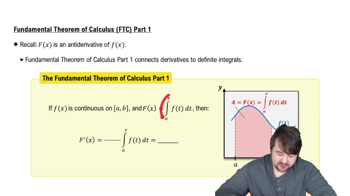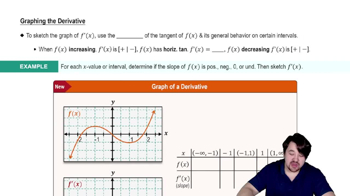If functions f(x) and g(x) are continuous for 0 ≤ x ≤ 1, could f(x)/g(x) possibly be discontinuous at a point of [0,1]? Give reasons for your answer.
Table of contents
- 0. Functions7h 54m
- Introduction to Functions16m
- Piecewise Functions10m
- Properties of Functions9m
- Common Functions1h 8m
- Transformations5m
- Combining Functions27m
- Exponent rules32m
- Exponential Functions28m
- Logarithmic Functions24m
- Properties of Logarithms36m
- Exponential & Logarithmic Equations35m
- Introduction to Trigonometric Functions38m
- Graphs of Trigonometric Functions44m
- Trigonometric Identities47m
- Inverse Trigonometric Functions48m
- 1. Limits and Continuity2h 2m
- 2. Intro to Derivatives1h 33m
- 3. Techniques of Differentiation3h 18m
- 4. Applications of Derivatives2h 38m
- 5. Graphical Applications of Derivatives6h 2m
- 6. Derivatives of Inverse, Exponential, & Logarithmic Functions2h 37m
- 7. Antiderivatives & Indefinite Integrals1h 26m
- 8. Definite Integrals4h 44m
- 9. Graphical Applications of Integrals2h 27m
- 10. Physics Applications of Integrals 3h 16m
- 11. Integrals of Inverse, Exponential, & Logarithmic Functions2h 31m
- 12. Techniques of Integration7h 41m
- 13. Intro to Differential Equations2h 55m
- 14. Sequences & Series5h 36m
- 15. Power Series2h 19m
- 16. Parametric Equations & Polar Coordinates7h 58m
1. Limits and Continuity
Continuity
Problem 2.5.72
Textbook Question
Use the Intermediate Value Theorem in Exercises 69–74 to prove that each equation has a solution. Then use a graphing calculator or computer grapher to solve the equations.
x³ − 15x + 1 = 0 (three roots)
 Verified step by step guidance
Verified step by step guidance1
Understand the Intermediate Value Theorem (IVT): It states that if a continuous function f(x) takes on values of opposite signs at two points a and b, then there exists at least one c in the interval (a, b) such that f(c) = 0.
Identify the function: Here, the function is f(x) = x³ − 15x + 1. This is a polynomial function, which is continuous everywhere.
Choose appropriate intervals: To apply the IVT, we need to find intervals where the function changes sign. Start by evaluating f(x) at various points to find intervals where f(x) changes from positive to negative or vice versa.
Evaluate the function at chosen points: Calculate f(x) at several points, such as f(-3), f(0), f(3), etc., to find intervals where the sign changes. For example, if f(-3) < 0 and f(0) > 0, then there is a root in the interval (-3, 0). Repeat this process to find all intervals where the function changes sign.
Use a graphing calculator or computer grapher: Once you have identified the intervals using the IVT, use a graphing tool to visualize the function and find the approximate values of the roots within those intervals.
 Verified video answer for a similar problem:
Verified video answer for a similar problem:This video solution was recommended by our tutors as helpful for the problem above
Video duration:
2mPlay a video:
Was this helpful?
Key Concepts
Here are the essential concepts you must grasp in order to answer the question correctly.
Intermediate Value Theorem
The Intermediate Value Theorem states that if a function is continuous on a closed interval [a, b] and takes on different signs at the endpoints (f(a) and f(b)), then there exists at least one c in (a, b) such that f(c) = 0. This theorem is fundamental for proving the existence of roots in continuous functions.
Recommended video:

Fundamental Theorem of Calculus Part 1
Continuous Functions
A continuous function is one where small changes in the input result in small changes in the output. Formally, a function f is continuous at a point x = c if the limit of f as x approaches c equals f(c). Understanding continuity is crucial for applying the Intermediate Value Theorem effectively.
Recommended video:

Intro to Continuity
Graphing Techniques
Graphing techniques involve using tools like graphing calculators or software to visualize functions. By plotting the function, one can identify where it crosses the x-axis, indicating the roots of the equation. This visual approach complements analytical methods like the Intermediate Value Theorem in finding solutions.
Recommended video:

Graphing The Derivative
Related Videos
Related Practice
Textbook Question


